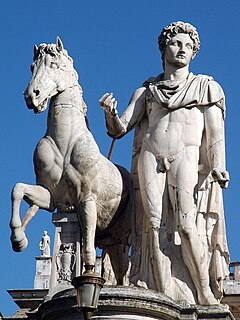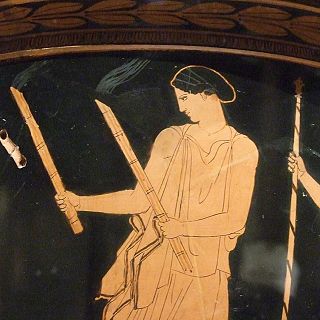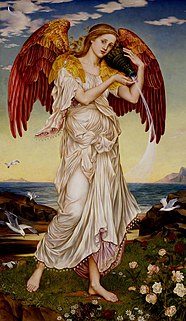Style
The Underworld Painter often exaggerated with decoration, so that the vases are a little overweight. In addition, he sometimes had problems with the representation of faces, so that its people appear grumpy. He strength was with the muscles naked men, which is depicted as taut and body stressing. This is reminiscent of Hellenistic sculptures. However, his painted legs are often quite thin. He attached great importance to some details. He carefully distinguished hair and patterned clothes. The Underworld painter in his repertoire is less original than the Darius painter, but he also shows some rarely shown Melanippe stories like the myth of two plays of Euripides. This story has so far not been found on any other vase. Also known from the Berlin Collection of Classical Antiquities is the Gigantomachy krater, the Priamiden krater and the krater of Persephone). The late work attributed to the artist is seen quite critically and shows a rapid decrease in the skill and quality. It is thought that it was no longer the work of the Underworld Painter, but the other painters of his workshop.
In Greek mythology, Melanippe referred to several different people:
The Antikensammlung Berlin is one of the most important collections of classical art in the world, now held in the Altes Museum and Pergamon Museum in Berlin, Germany. It contains thousands of ancient archaeological artefacts from the ancient Greek, Roman, Etruscan and Cypriot civilizations. Its main attraction is the Pergamon Altar and Greek and Roman architectural elements from Priene, Magnesia, Baalbek and Falerii. In addition, the collection includes a large number of ancient sculptures, vases, terracottas, bronzes, sarcophagi, engraved gems and metalwork.

A krater or crater was a large vase in Ancient Greece, particularly used for watering down wine.
This page is based on this
Wikipedia article Text is available under the
CC BY-SA 4.0 license; additional terms may apply.
Images, videos and audio are available under their respective licenses.

Castor and Pollux were twin half-brothers in Greek and Roman mythology, known together as the Dioscuri.

Black-figure pottery painting, also known as the black-figure style or black-figure ceramic is one of the styles of painting on antique Greek vases. It was especially common between the 7th and 5th centuries BC, although there are specimens dating as late as the 2nd century BC. Stylistically it can be distinguished from the preceding orientalizing period and the subsequent red-figure pottery style.

Exekias was an ancient Greek vase-painter and potter who was active in Athens between roughly 545 BC and 530 BC. Exekias worked mainly in the black-figure technique, which involved the painting of scenes using a clay slip that fired to black, with details created through incision. Exekias is regarded by art historians as an artistic visionary whose masterful use of incision and psychologically sensitive compositions mark him as one of the greatest of all Attic vase painters. The Andokides painter and the Lysippides Painter are thought to have been students of Exekias.

Red-figure vase painting is one of the most important styles of figural Greek vase painting.
The Kleophon Painter is the name given to an anonymous Athenian vase painter in the "red figure" style who flourished in the mid-to-late 5th century BCE. He is thus named because one of the works attributed to him bears an inscription in praise of a youth named "Kleophon". He appears to have been originally from the workshop of Polygnotos, and in turn to have taught the so-called "Dinos Painter". Three vases suggest a collaboration with the Achilles Painter, while a number of "black figure" works have also been attributed to him by some scholars.

Euphronios was an ancient Greek vase painter and potter, active in Athens in the late 6th and early 5th centuries BC. As part of the so-called "Pioneer Group,", Euphronios was one of the most important artists of the red-figure technique. His works place him at the transition from Late Archaic to Early Classical art, and he is one of the first known artists in history to have signed his work.

The Niobid Painter was an ancient Athenian vase painter in the red figure style who was active from approximately 470 to 450 BC. He is named after a calyx krater which shows the god Apollo and his sister Artemis killing the children of Niobe who were collectively called the Niobids. The krater is known as the Niobid Krater and is now housed at the Louvre in Paris. In his other work he shows a preference for Amazonomachy scenes and three-quarter-view faces. His student Polygnotos continued his style of vase painting.

Lydos was an Attic vase painter in the black-figure style. Active between about 560 and 540 BC, he was the main representative of the '’’Lydos Group’’’. His signature, ό Λυδός, ho Lydos, the Lydian, inscribed on two vases, is informative regarding the cultural background of the artist. Either he immigrated to Athens from the Lydian empire of King Kroisos, or he was born in Athens as the son of Lydian parents. In any case, he learned his trade in Athens.

Epiktetos was an Attic vase painter in the early red-figure style. Besides Oltos, he was the most important painter of the Pioneer Group. He was active between 520 BC and 490 BC. His name translates as "newly acquired" which is most probably a reference to his slave status.

The Sisyphus Painter was an Apulian red-figure vase painter. His works are dated to the last two decades of the fifth century and the very early fourth century BC.

The Ilioupersis Painter was an Apulian vase painter. His works are dated to the second quarter of the 4th century BC.

The Baltimore Painter was an ancient Greek Apulian vase painter whose works date to the final quarter of the 4th century BC. He is considered the most important Late Apulian vase painter, and the last Apulian painter of importance. His conventional name is derived from a vase kept at the Walters Art Museum in Baltimore.

The Varrese Painter was an Apulian red-figure vase painter. His works are dated to the middle of the 4th century BC.

A bident is a two-pronged implement resembling a pitchfork. In classical mythology, the bident is a weapon associated with Hades, the ruler of the underworld. Likewise, the three-pronged trident is the implement of his brother Poseidon (Neptune), god of the seas and earthquakes, and the lightning bolt, which superficially looks as if it has one prong, is a symbol of Zeus.

The Persephone Painter, working from about 475 to the 425 BCE, is the pseudonym of an ancient Attic Greek vase-painter, named by Sir John Beazley after investigating a red-figure bell-krater vase of about 440 BCE which includes a mythological scene of the return of Persephone from Hades. This name vase of the Persephone Painter currently resides at the Metropolitan Museum of Art in New York City.

Campanian vase painting is one of the five regional styles of South Italian red-figure vase painting. It forms a close stylistic community with Apulian vase painting.

The Painter of the Berlin Dancing Girl was an Apulian red-figure vase painter who was active between 430–410 BC. He was named after a calyx krater in the collection of the Antikensammlung Berlin which depicts a girl dancing to the aulos played by a seated woman.

The Odysseus in the Underworld krater is a Lucanian kalyx-krater decorated in the red-figure style dating to ca. 380 BC - ca. 360 BC. It was found in Pisticci, south Italy and is believed to be the work of the Dolon painter, a famous Lucanian red-figure vase painter who worked in the Metaponto workshop and had a particular affinity for large krateres and mythological scenes. The krater is now at the Bibliothèque Nationale in Paris.



























